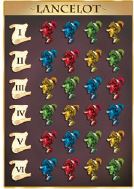
2 Player Game - Easy Rules
« Karadoc » Rules
It is similar to a 3 player game, the third player being a neutral player. The first player will alternate between the 2 real players.
When the neutral player has a choice, it's the first player who will make the choice for him.
Phase 2 - Draft The Learning Cards
Don't forget to alternate the draft direction, as shown on the parchment used to count the turns.
When the neutral player has to choose a card, he takes the card with the highest value. The player who gives the cards to the neutral player in the draft phase plays the draft phase for the neutral player, he places the cards chosen by the neutral player (according to the rule) face down in front of the neutral player area.
appears on more than one card, then those cards are shuffled and one of them is chosen randomly and placed face down in front of the neutral player area.
Just like in the normal game, once the neutral player has taken a card, the remaining ones are given to the next player.
Phase 3 - Play The Learning Cards
When it's the neutral player's turn to play a card, the first player randomly takes a card in the neutral player's hand and plays it face up. He then moves the neutral player's disc on the
Reminder : If the neutral player has a choice, for example with a Jousts/Tournaments card, the first player makes the choice.
Phase 4 - Scoring
If the neutral player has a bonus on the Gallantry game board and has to choose where to move up, the first player makes that choice.
Coats of arms are given as if the neutral player was a real player. Reminder : in a 3 player game, the third place never gives you anything positive.
At the end of the game, you don't have to count the neutral player score, but if you want to, you can compare it to your own score!
2 Player Game - The Real Deal
« Lancelot » Rules

Those rules replace the easy rules.
In this game, each player plays 2 different colors, as if it was a 4 player game. The score of a player is the sum of th e score of each of his colors. One player plays blue and green, the other plays yellow and red.
The order for phase 3 (playing the cards) is shown on the « Turn Order » card..
Phase 1 - Dealing the Learning Cards
The first player shuffles the 52 Learning cards and deals 6 cards to each player.
Phase 2 - Exchanging Learning Cards
Each player looks at his cards, and divides them into 2 stacks of 3 cards each (face down).
Once all 4 stacks are done, they are revealed (cards face up).
The first player chooses one of the stacks made by the other player, and takes the 3 cards in his hand. The other stack made by the second player goes in the hand of the second player.
Then the second player chooses one of the stacks made by the first player, and takes the 3 cards in his hand. The other stack made by the first player goes in the hand of the first player.
Each player now has 6 cards in his hand.
He secretly divides those 6 cards in 3 cards for each of his colors: The red/yellow player puts 3 cards face down under a red disc, and 3 cards face down under a yellow disc. The blue/green player does the same with a blue disc and a green disc.
Phase 3 - Playing the Learning Cards
In the order shown on the « Turn Order » card, players play their colors. Playing a color means playing the 3 cards chosen for that color all at once, and move the discs on the game boards accordingly.
Phase 4,5,6
The rest of the game is the same as a 4 player game
Continue Reading
